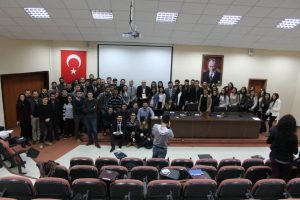The Research and Development activities of Iskenderler Aluminum Inc. can be categorized in three main groups:
1. Master Thesis produced by the Research and Development team:
Title: Effects of Casting Conditions on End Product Defects in Direct Chill Casted Hot Rolling Ingots
Author: Author: Arda YORULMAZ
Supervisor: Supervisor: Assoc. Prof. Dr. Derya DIŞPINAR
Istanbul University Institute of Graduate Studies in Science and Engineering Department of Metallurgical and Materials Engineering
Abstract: Direct chill casting is an important casting method for production of extrusion billets, hot rolling ingots, and remelt T ingots. Like every casting method, melt quality effects end product quality. Melt quality is directly related to casting conditions. In this study in a production facility which produces thin aluminum discs with Al 1050 alloy for kitchenware industry, melt treatment options, launder designs were examined and results are shown. It was shown that quiescent and turbulance free flow, porous plug degassing are adequate melt quality practices and bifilm index is an effective melt quality measurement.
Keywords: Aluminium, blister, porosity, bifilm index.
Further readings: http://acikerisim.istanbul.edu.tr/bitstream/handle/123456789/6648/55063.pdf?sequence=1&isAllowed=y
2. Academic Publication
As an output of our R & D team, the following paper is published in SHAPE CASTING: 6th International Syposium.
Title: Effects of Casting Conditions on End Product Defects in Direct Chill Casted Hot Rolling Ingots
Authors: Arda Yorulmaz, Caglar Yaksel, Eraz Erzi, and Derya Dispinar
Abstract:
Collaborative work between Iskenderler Inc. & Istanbul University & Yildiz Technical University
Direct chill casting is a reliable casting process for almost any wrought aluminum alloy for subsequent deformation via hot rolling to supply vital industries such as aerospace, automotive, construction, packaging and maritime. While some defects occur during casting, like hot tearing, some others like surface defect causing blisters, appear after hot rolling process or annealing after final cold rolling steps. It was found that some of these defects are caused by melt impurities formed from entrained folded aluminum oxides or bifilms. A study in a hot rolling casting facility was carried out with different melt cleaning practices, launder and molten metal transferring designs. Bifilm index and reduced pressure test were used for determining melt cleanliness measurement. It was found that porous plug gas diffusors for degassing are more effective than lance type degassers and a design towards less turbulent molten metal flow from furnace to mould cavity are necessary for reducing defects caused by bifilms.
Further readings:
1.https://link.springer.com/chapter/10.1007/978-3-319-48166-1_23
2.https://onlinelibrary.wiley.com/doi/abs/10.1002/9781119274865.ch23
Anahtar Kelimeler: direct chill casting, blister, porosity, bifilm index, molten metal treatment.
3. Academic Events
Iskenderler Aluminum Inc. has participated Istanbul University Aluminum Summit Istanbul University Metallurgical Engineering Summit in 2015.
Event pictures can be found on the Istanbul University Department of Metallurgical and Materials Engineering Facebook Page.
https://www.facebook.com/metalurjivemalzeme/photos/a.772445402862431/772450196195285/?typ e=3&theater





